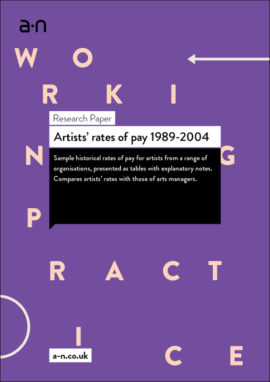The arts in criminal justice: a study of research feasibility
Report focusing on practical, logistical and methodological issues involved in carrying out effective research on impacts of arts interventions in criminal justice settings.
Report focusing on practical, logistical and methodological issues involved in carrying out effective research on impacts of arts interventions in criminal justice settings.
A glimpse into the working lives of artists, highlighting discrepancies between the perceptions and realities of professional artistic practice.
Summary of the 2005–06 Future forecast programme, marking a-n’s 25th anniversary, presenting an overview of a comprehensive enquiry into the conditions of art production in the UK. The introduction contextualises the evidence within the current social and cultural climate, with the final section setting out a series of measures across five key areas that will enhance artists’ developments.
Assesses the scale of arts festival activity in Yorkshire in 2006, and development needs of the sector as indicated through analysis of case studies.
Accompanies the ‘Art work 1989 – 2003′ analysis of artists’ jobs and opportunities. Reviews the situation in 2005 and compares findings with those from 2003. Discusses the implications for artists in 2006 and beyond.
Describes three different prototypes that created new interpretation and visitor interaction.
Loic Tallon describes a piece of independent research into audioguides and their use and potential in galleries and museums.
Stephen Foster, director of John Hansard Gallery, critiques the leadership role and explains how project funding leads to a loss of distinctiveness in the nations’ public galleries.
Data on employment conditions and diversity in contemporary visual arts organisations, with comparators to theatre, broadcasting and media, and visual arts in Germany. Published 2005.
Part of the 2005-06 Future forecast series, marking a-n’s 25th anniversary, Curated space looks at strategies and interventions within artist-curator practice.
Part of the 2005-06 Future forecast series, marking a-n’s 25th anniversary, Social space addresses dynamics and divergences within artists’ practice in the social realm.
Explores impact of artists working in educational settings through arts-based interventions organised in what were education action zones of Bristol and Corby, pre Creative Partnerships.
Part of a-n’s 2005-06 Future forecast series, marking its 25th anniversary, Future space addresses the future roles and functions of artists’ workspace.
Provides sample historical rates of pay for artists from a range of organisations and compares artists’ rates with those of arts managers.
Regional report mapping the creative industries sector in Devon and Torbay, and making recommendations for its support and growth.
The first survey of its kind, intended to provide the beginning of a national register of artists’ studio groups and organisations.
Associated with the Visual Intelligence project at Lancaster University, asks whether it is possible to chart the evolution of an artist’s creative thought through their making processes.
Profile of the shared workspaces and related services used by visual artists and craftspeople in the Yorkshire and Humberside region in 2005.
2005 report on the working environment of West Midlands designer makers, craftspeople and applied artists at different stages of their careers. It was undertaken to explore activity, identify needs and gaps in provision of professional development support.
In 2004, a-n commissioned a team from University of Newcastle to undertake research into context, attitudes and approaches to paying artists for their skills and services.
Quality indicators and advice for planning, commissioning and delivery.
Presents findings of research on social inclusion in the arts.
ACE document from 2003 highlighting the value of open studios for artists, audiences, local arts and economic and social developmental strategies.
Reflects on engagement between artists and participants during the Artists in Sites for Learning scheme.
Draws together the regional and national evaluations of the 2000 – 2001 ACE sponsored Year of the Artist, which commissioned 1000 artist residencies.













